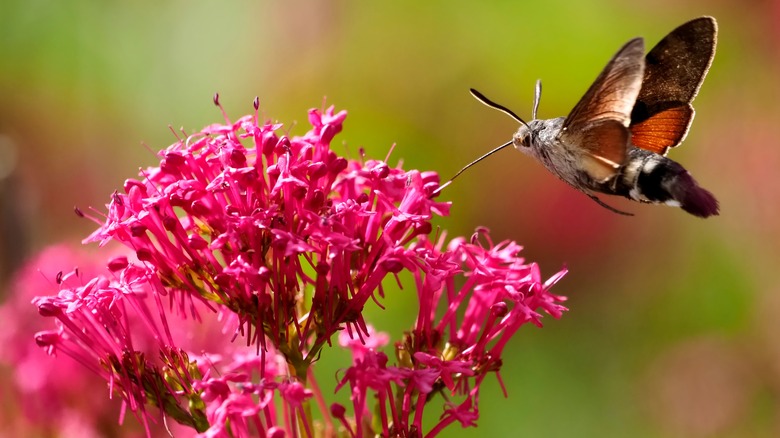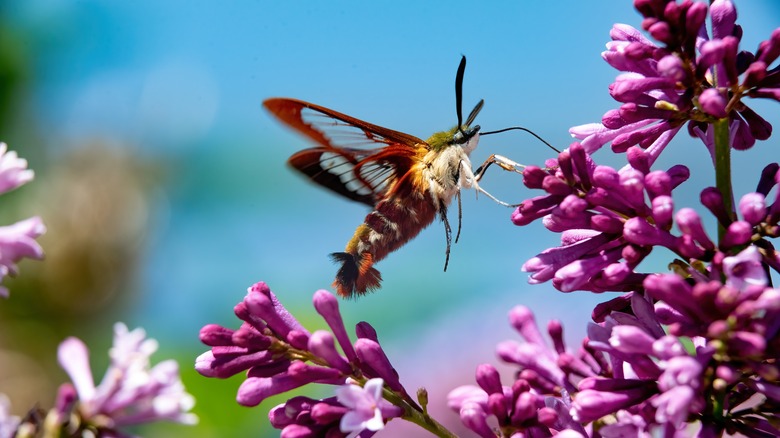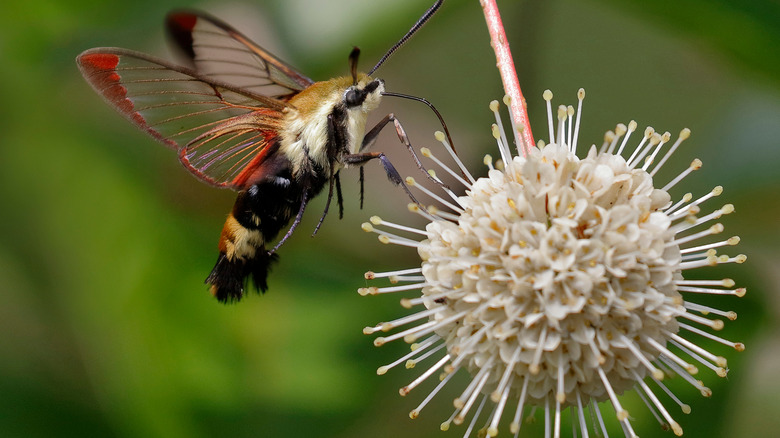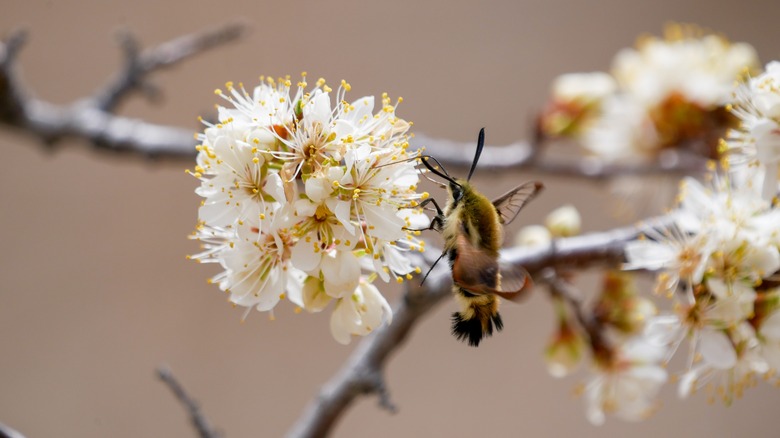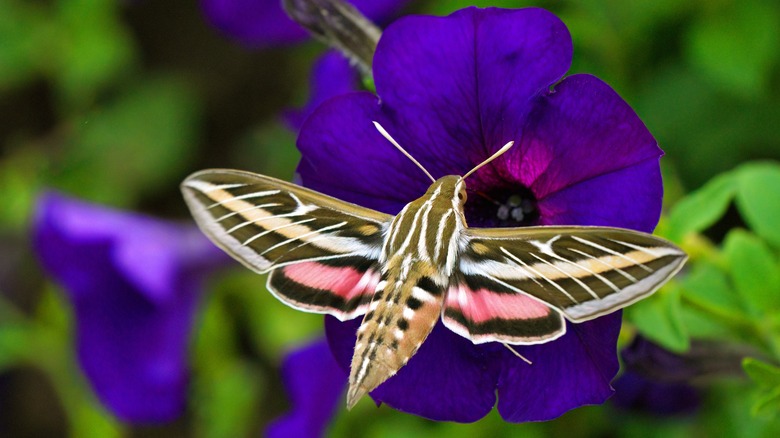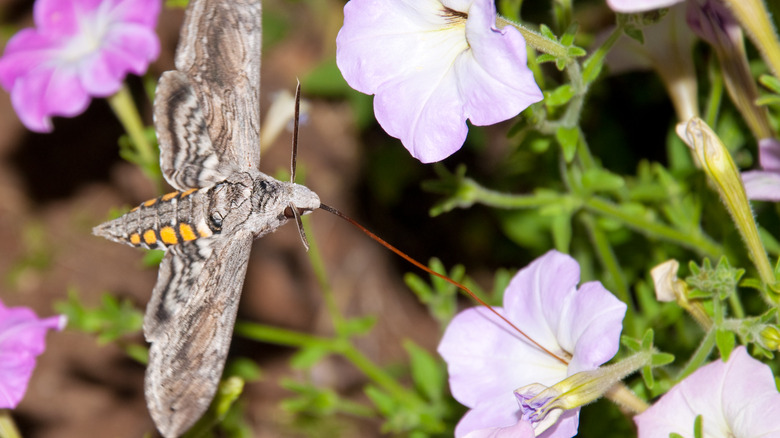Hummingbird Moths That Could Visit Your Garden (& Which To Keep Away)
Few things are as fulfilling as cultivating a garden filled with diverse wildlife. One beloved backyard visitor, the hummingbird, is often confused with another pollinator — the hummingbird moth. These remarkable creatures mimic the appearance and behavior of their avian namesake, rapidly flapping their wings and hovering near flowers as they sip nectar. Although many of these moths are beneficial pollinators that are welcome in our backyards, others may pose a threat to your plants — such as the five-spotted hawkmoth (Manduca quinquemaculata).
Also known as sphinx moths, these fascinating insects belong to the Sphingidae family, which has over 1,400 species worldwide. In North America, there are 115 types, including four species of Hemaris hummingbird moths, with the most common being the snowberry clearwing (Hemaris diffinis) and the common clearwing hummingbird moth (Hemaris thysbe). Typically, their coloring includes shades of red and brown, which can look quite similar to the rufous hummingbird (Selasphorus rufus). While many species are harmless (and fun to watch), some of these insects have destructive larvae with voracious appetites and can cause significant damage to crops and foliage. Thankfully, there are several methods to kicking out the unwanted guests without getting rid of any helpful pollinators. Below, we'll explore a few of the most common hummingbird moth species and help you distinguish garden-friendly visitors from those that could be harmful.
Common clearwing hummingbird moth
If you hear a buzzing in your garden and see a small, fuzzy creature hovering by your flowers, you may mistake it for a hummingbird. Upon closer inspection, you'd be able to tell this tiny acrobatic flier is instead a common clearwing hummingbird moth. Not only are these moths about the same size as hummingbird fledglings, but their rapid wing flapping can create that familiar humming sound. If you're lucky enough to get close to one, you can identify this species by its olive-green back, reddish-brown abdomen, and whitish front and legs. Like other hummingbird moths, these intriguing insects also have big eyes, thick bodies, and a wingspan of 1 ½ to a little over 2 inches.
Common clearwing hummingbird moths are the most common of the species in North America and are often seen in flower gardens between late spring and early fall. Although their caterpillars may leave behind chew marks or cause some defoliation on plants, it's more likely you won't notice them in your garden. Not only are the adults harmless, but their favorite flowers to drink from are often varieties that smaller-tongued pollinators leave behind. Deep-throated flowers are often more challenging for smaller insects to reach, but these fascinating moths can use their long proboscises to pollinate them, supporting the health of your garden. Although they can be seen across North America, you're more likely to spot them in eastern states.
Snowberry clearwing
With its furry yellow-and-black-striped body, you may mistake the snowberry clearwing for a bumblebee at first glance. Their costume helps protect them, as predators assume they could get stung and think twice about attacking. If you catch a view from a different angle, the moth's fanned tail and mannerisms may have you believe you spotted a hummingbird. Like other members of the Hemaris genus, these inch-long creatures display a mesmerizing ability to hover in place as they unfurl their tongues into nectar. Visually, their transparent wings with reddish-brown terminal borders are the primary difference that sets them apart from similar-looking animals.
You're most likely to see snowberry clearwings in the eastern half of the United States, although they can also be found in some parts of the west. Living in a wide range of habitats, you may observe them enjoying nectar from their favorite flowers like snowberry (Symphoricarpos albus) or lilac (Syringa vulgaris) in the summer. Adult moths lay eggs on plants, which hatch into greenish to brownish caterpillars that will fuel up by eating the surrounding foliage. Don't fret; even if their larvae live in your garden, they won't cause any damage. These tiny pollinators contribute to the health and diversity of your backyard ecosystem. Planting vibrant, sweet-smelling flowers is one of the best ways to attract these hummingbird-like creatures to your garden.
Rocky Mountain clearwing
Another bumblebee mimic, the Rocky Mountain clearwing (Hemaris thetis), is known for its striking resemblance to the striped pollinator, which, like the snowberry clearing, helps it avoid predators while feeding on nectar. Like other clearwing species, their rapidly flapping wings cause its scales to shed, giving them the nickname clearwings. Although they look strikingly similar to their snowberry cousins, they have some slight differences. Snowberry clearwings have more of a golden-hued thorax, while the Rocky Mountain species is more brownish. Additionally, the key identifying difference is the red spot at the tip of their forewings, which isn't present on snowberry clearwings.
If you can't get a close enough look to identify the species, you can more easily rely on your location to tell the difference. Aptly named, Rocky Mountain clearwings are most prominent in the western region of the United States and Canada, specifically the Pacific Northwest. Not only do they share their good looks with other Hemaris members, but their larvae are also generally harmless and are not considered pests. As beneficial insects, you can lure them into your yard by planting flowers that attract pollinators, such as dogbane (Apocynum cannabinum) and honeysuckle (Lonicera periclymenum).
White-lined sphinx moth
The white-lined sphinx moth (Hyles lineata) is a hummingbird moth that gets its name from the way its caterpillar lifts its front legs and tucks its head when at rest, resembling the Great Sphinx of Giza. In its adult form, it becomes a striking and large moth with a wingspan that ranges from 2 ½ to 3 ½ inches. Its front wings are a deep brown with a yellowish-tan stripe running from the body to the tip, accented by white lines along the veins. The hindwings feature a pretty pink band between two black markings. Like many moths in the Sphingidae family, this species has a furry body and hummingbird-like flight patterns.
This type of moth is extremely common and has a wide geographic range across North America, including southern Canada, many of the United States, and Mexico. It typically prefers open spaces and can be found in various habitats, including deserts, grasslands, conifer forests, high mountain meadows, and urban areas, such as your flower garden. Although this species isn't considered a major pest, its larvae can sometimes damage fruits. These caterpillars feast on a wide array of foliage, though they are particularly fond of grapes and can be considered sporadic pests of these plants. That said, these moths are important for our ecosystems, so reducing pesticide use and offering food and shelter go a long way in providing them with a safe habitat. Primarily nocturnal, planting light-colored flowers that reflect off the moonlight can also be helpful.
Five-spotted hawkmoth
Among the fascinating species of hummingbird moths, the five-spotted hawkmoth stands out for a few reasons. One of the largest members on our list, this moth has a wingspan that can reach over 5 inches. Its wings are brownish-gray with darker lines that weave together in an intricate wavy pattern. Their forewings are long and narrow, while the hindwings are shorter and have more contrast. The moth's body is gray with blue and black spots along the thorax and yellow dots lining each side of the abdomen. Five-spotted hawkmoths are widespread across North America, appearing in nearly every state.
Although adults aren't necessarily a cause for concern, their larvae — which you might know as the tomato hornworm — can damage crops. These green to brown beasts can reach up to 5 inches long and have a distinctive horn-like tail, making them easy to spot in your garden. Their favorite plants are members of the nightshade or Solanaceae family, which includes tomato, tobacco, potato, and pepper plants. The best way to get rid of tomato worms is using natural methods to avoid hurting other crucial insects in your garden. If you spot them, you can hand-pick them off your plants and dunk them in water to kill them. Yarrow (Achillea millefolium) is a gorgeous flowering favorite that can help you get a handle on garden pests, like tomato hornworms, by attracting parasitic wasps. Even sometimes called the hornworm wasp, this insect eats hornworms from the inside out.
